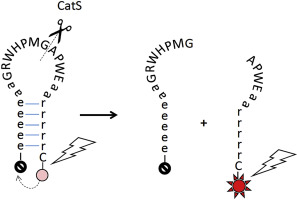Our official English website, www.x-mol.net, welcomes your
feedback! (Note: you will need to create a separate account there.)
Imaging of extracellular cathepsin S activity by a selective near infrared fluorescence substrate-based probe.
Biochimie ( IF 3.3 ) Pub Date : 2019-03-23 , DOI: 10.1016/j.biochi.2019.03.013 Mylène Wartenberg 1 , Ahlame Saidi 1 , Mathieu Galibert 2 , Alix Joulin-Giet 1 , Julien Burlaud-Gaillard 3 , Fabien Lecaille 1 , Christopher J Scott 4 , Vincent Aucagne 2 , Agnès F Delmas 2 , Gilles Lalmanach 1
Biochimie ( IF 3.3 ) Pub Date : 2019-03-23 , DOI: 10.1016/j.biochi.2019.03.013 Mylène Wartenberg 1 , Ahlame Saidi 1 , Mathieu Galibert 2 , Alix Joulin-Giet 1 , Julien Burlaud-Gaillard 3 , Fabien Lecaille 1 , Christopher J Scott 4 , Vincent Aucagne 2 , Agnès F Delmas 2 , Gilles Lalmanach 1
Affiliation

|
We designed a near-infrared fluorescent substrate-based probe (SBP), termed MG101, for monitoring extracellular cathepsin S (CatS) activity. We conceived a fused peptide hairpin loop-structure, combining a CatS recognition domain, an electrostatic zipper (with complementary charges of a polyanionic (D-Glu)5 segment and a polycationic (D-Arg)5 motif, as well as a N and C terminal Förster resonance energy transfer pair (donor: AlexaFluor680; quencher: BHQ3) to facilitate activity-dependent imaging. MG101 showed excellent stability since no fluorescence release corresponding to a self-dequenching was observed in the presence of either 2 M NaCl or after incubation at a broad range of pH (2.2-8.2). Cathepsins B, D, G, H, and K, neutrophil elastase and proteinase 3 did not cleave MG101, while CatS, and to a lesser extent CatL, hydrolysed MG101 at pH 5.5. However MG101 was fully selective for CatS at pH 7.4 (kcat/Km = 140,000 M-1 s-1) and sensitive to low concentration of CatS (<1 nM). The selectivity of MG101 was successfully endorsed ex vivo, as it was hydrolysed in cell lysates derived from wild-type but not knockout CatS murine spleen. Furthermore, application of the SBP probe with confocal microscopy confirmed the secretion of active CatS from THP-1 macrophages, which could be abrogated by pharmacological CatS inhibitors. Taken together, present data highlight MG101 as a novel near-infrared fluorescent SBP for the visualization of extracellular active CatS from macrophages and other cell types.
中文翻译:

通过选择性的基于近红外荧光底物的探针对细胞外组织蛋白酶S活性进行成像。
我们设计了一种基于近红外荧光底物的探针(SBP),称为MG101,用于监测细胞外组织蛋白酶S(CatS)的活性。我们构想了融合的肽发夹环结构,结合了CatS识别域,静电拉链(带有聚阴离子(D-Glu)5片段和聚阳离子(D-Arg)5基序的互补电荷,以及N和C末端Förster共振能量转移对(供体:AlexaFluor680;淬灭剂:BHQ3),有助于进行依赖于活性的成像,MG101显示出极好的稳定性,因为在存在2 M NaCl或孵育后均未观察到与自脱模相应的荧光释放在宽范围的pH值(2.2-8.2)下,组织蛋白酶B,D,G,H和K的中性粒细胞弹性蛋白酶和蛋白酶3不会裂解MG101,而CatS和CatL在较小的程度上水解了pH101的MG101。但是,MG101对pH 7.4(kcat / Km = 140,000 M-1 s-1)的CatS具有完全选择性,并且对低浓度的CatS(<1 nM)敏感。MG101的选择性在体外得到了成功的认可,因为它在衍生自野生型而不是敲除CatS鼠脾的细胞裂解物中被水解。此外,通过共聚焦显微镜对SBP探针的应用证实了THP-1巨噬细胞中有活性的CatS分泌,这可以被药理学的CatS抑制剂消除。综上所述,当前数据突出显示了MG101作为一种新型的近红外荧光SBP,可用于可视化巨噬细胞和其他细胞类型的细胞外活性CatS。因为它在衍生自野生型的细胞裂解物中被水解,但未敲除CatS鼠脾脏。此外,通过共聚焦显微镜对SBP探针的应用证实了THP-1巨噬细胞中有活性的CatS分泌,这可以被药理学的CatS抑制剂消除。综上所述,目前的数据突出了MG101作为一种新型近红外荧光SBP,用于可视化巨噬细胞和其他细胞类型的细胞外活性CatS。因为它在衍生自野生型的细胞裂解物中被水解,但未敲除CatS鼠脾脏。此外,通过共聚焦显微镜对SBP探针的应用证实了THP-1巨噬细胞中有活性的CatS分泌,这可以被药理学的CatS抑制剂消除。综上所述,目前的数据突出了MG101作为一种新型近红外荧光SBP,用于可视化巨噬细胞和其他细胞类型的细胞外活性CatS。
更新日期:2019-03-25
中文翻译:

通过选择性的基于近红外荧光底物的探针对细胞外组织蛋白酶S活性进行成像。
我们设计了一种基于近红外荧光底物的探针(SBP),称为MG101,用于监测细胞外组织蛋白酶S(CatS)的活性。我们构想了融合的肽发夹环结构,结合了CatS识别域,静电拉链(带有聚阴离子(D-Glu)5片段和聚阳离子(D-Arg)5基序的互补电荷,以及N和C末端Förster共振能量转移对(供体:AlexaFluor680;淬灭剂:BHQ3),有助于进行依赖于活性的成像,MG101显示出极好的稳定性,因为在存在2 M NaCl或孵育后均未观察到与自脱模相应的荧光释放在宽范围的pH值(2.2-8.2)下,组织蛋白酶B,D,G,H和K的中性粒细胞弹性蛋白酶和蛋白酶3不会裂解MG101,而CatS和CatL在较小的程度上水解了pH101的MG101。但是,MG101对pH 7.4(kcat / Km = 140,000 M-1 s-1)的CatS具有完全选择性,并且对低浓度的CatS(<1 nM)敏感。MG101的选择性在体外得到了成功的认可,因为它在衍生自野生型而不是敲除CatS鼠脾的细胞裂解物中被水解。此外,通过共聚焦显微镜对SBP探针的应用证实了THP-1巨噬细胞中有活性的CatS分泌,这可以被药理学的CatS抑制剂消除。综上所述,当前数据突出显示了MG101作为一种新型的近红外荧光SBP,可用于可视化巨噬细胞和其他细胞类型的细胞外活性CatS。因为它在衍生自野生型的细胞裂解物中被水解,但未敲除CatS鼠脾脏。此外,通过共聚焦显微镜对SBP探针的应用证实了THP-1巨噬细胞中有活性的CatS分泌,这可以被药理学的CatS抑制剂消除。综上所述,目前的数据突出了MG101作为一种新型近红外荧光SBP,用于可视化巨噬细胞和其他细胞类型的细胞外活性CatS。因为它在衍生自野生型的细胞裂解物中被水解,但未敲除CatS鼠脾脏。此外,通过共聚焦显微镜对SBP探针的应用证实了THP-1巨噬细胞中有活性的CatS分泌,这可以被药理学的CatS抑制剂消除。综上所述,目前的数据突出了MG101作为一种新型近红外荧光SBP,用于可视化巨噬细胞和其他细胞类型的细胞外活性CatS。











































 京公网安备 11010802027423号
京公网安备 11010802027423号